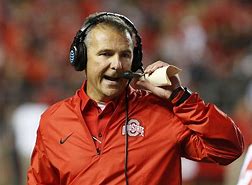Tonight, we learned that the current head coach of the Ohio State Buckeyes, Urban Meyer, has been placed on administrative leave pending a further investigation surrounding how much or little he knew about the reprehensible actions of a long-time assistant coach on his football staff, wide receivers coach Zach Smith. Smith was recently fired after several incidents of domestic violence and felony assault came to light.
Zach Smith had also worked on the University of Florida football staff of that same head coach, Urban Meyer. So, at least we’ve established that the two coaches have known each other quite well for at least ten years.
Ohio State University wants to understand whether their head football coach knowingly kept his long-time coaching associate on the staff regardless of his personal transgressions off the field.
This article isn’t to either condone anyone’s actions. Lord knows, the 24/7 “we need a hot story” media will continue to swarm around this story enough for everyone.
My purpose with this article was to simply reflect on the incredible number of duties which college football (or basketball or baseball) coaches are now (apparently) responsible for.
It wasn’t too many years ago that a college coach would be primarily judged by wins and losses and number of tickets sold to those events to pay the bills for the university.
Back then, though, that same successful college football coach may make “only” two or three times the salary of the best university professors. Sure, they would get complimentary meals around town and, perhaps, a glance the other way from the local police officer if he was going over the speed limit.
My how times have changed. Urban Meyer is scheduled to make an incredible $7.6 million this year to coach the football program of a state university! Meanwhile, Professor Beaker in the university’s Chemistry Department might earn $100,000 for his time in the classroom and lab with the students this year.
So, why is the head football coach paid so much? Do some quick math. Take 100,000 seats times $50 per seat times eight games per season equals $40 million per season in home field ticket revenue for the university. And that doesn’t include the concessions, parking, radio and television fees paid to the school, and all of those t-shirts, mugs, and hats being peddled to alumni and fans throughout the country for a percentage of the profits.
If that coach can deliver a winning product on the field, the head football coach can be an exceptionally good investment for the school’s finances.
Most of those dollars are used by the athletics department to financially prop-up virtually every other sport on campus (including women’s sports).
That’s a fact, Jack.
So is Urban Meyer worth $7.6 million? What about Nick Saban of the Alabama Crimson Tide? Is he worth his $11.25 million paycheck in 2018?
I certainly don’t think so, but, the math and the revenue figures certainly can make a persuasive argument to the contrary.
For that kind of money, though, comes the “rub”.
These days, the university’s head coach is expected to run a clean program and follow the voluminous and ever-changing and petty NCAA rules (good luck with that). Coaches today are expected to police the behavior and academic success of their players (from the time they sign a scholarship until the day they leave the school). Don’t forget the wealthy exuberant and influential university benefactors who want to bask in the glory of the university’s success and find creative ways to thank the players by providing “green” handshakes and other forms of gratitude.
And, based on today’s story, we can confirm that the head coach has now become the Head Sheriff over his coaching staff’s personal lives, too.
All while fielding a competitive team that pleases enough fans to buy enough highly priced tickets to keep college football’s fall financial gravy train rolling in the dough for another year.
For comparison, the CEO of a New York Stock Exchange-listed company I have worked for earned a stated annual salary in 2017 of nearly $500,000 (double it with bonuses and stock options) and is responsible for nearly 500 employees. The company generated a net profit last year of $86 million. That CEO is asked to “win” financially for the stockholders, keep the paychecks coming for the employees, and is held to account for the failings of his organization, too.
Most CEO’s are trained in business and finance and have a legal department, human resources, and other departments at their disposal to support the CEO’s efforts and take care of “bad” employees.
We are now asking these college football/basketball/baseball CEO’s to assume many responsibilities which they are (generally speaking) not trained to do.
For that kind of pay, though, the time has come for that same head coach to reach into his own deep pockets and pay for a team of legal, human resources, private investigators, counselors, and other associates to help run and police the big show, too.

